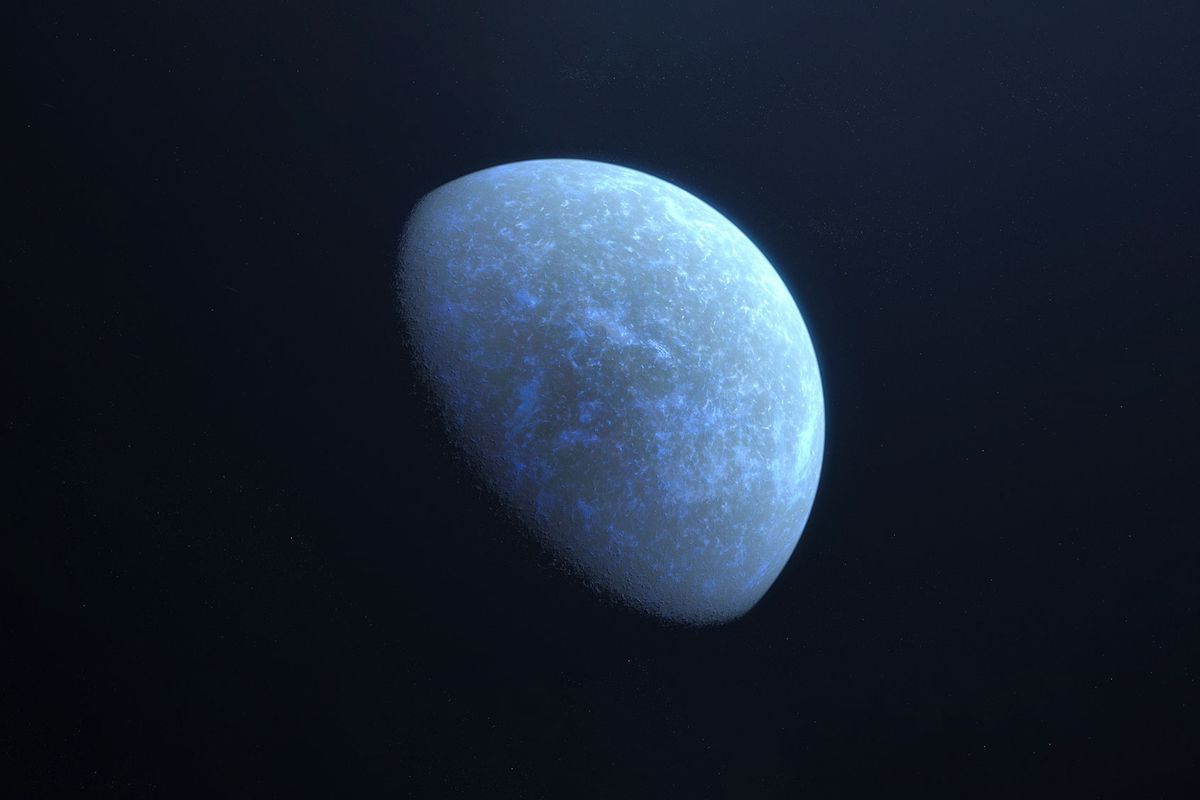Although the exoplanet TOI-1853 b is roughly the size of Neptune, its mass is almost twice that of any other known planet of comparable size. For this reason, TOI-1853 b should not exist, at least based on the known laws of physics. That is why some scientists have a bold hypothesis — that the strange alien world may only be around because a group of smaller planets collided into each other, according to a recent study in the journal Nature.
Neptune itself is a gas giant 57 times Earth’s size and covered in a thick atmosphere of hydrogen and helium, an icy world far away from its Sun. Other Neptune-sized worlds like the exoplanets HD 95338 b, TOI-849 b and TOI-2196 b contain lots of water or rock with thinner atmospheres — but are still nowhere near as dense as TOI-1853 b.
In fact, TOI-1853 b is so heavy that it possesses 73 times Earth’s mass — and uncharacteristically for a planet this size, it is so close to its star that it completes an orbit every 1.24 days.
What explains the existence of this freakishly large, freakishly heavy planet where a year is roughly the length of a Monday? A team of scientists, led by Luca Naponiello of University of Rome Tor Vergata and the University of Bristol, have a doozy of a hypothesis: TOI-1853 b was created when many other planets smashed together.
If true, this would mean that a number of smaller planets once orbited this exoplanet’s host star, TOI-1853. When their orbits destabilized, the planets may have begun crashing into each other, one right after another, forming one large, dense planet. This would essentially be the planetary equivalent of a twin consuming its sibling in the womb. As a result, the shattered individual planets formed a massive new planet in its unorthodox location second from its star. Yet this hypothesis is somewhat undermined by the fact that when planets crash into each other, they usually form multiple bodies rather than just one.
Another possibility is that a group of gas giants had formed in a farther obit more traditional for those types of planets, but that their orbits somehow destabilized. If that happened, one of them could been bounced into its current unusual orbit while gathering denser materials from the inner portions of its planet-forming disk. Eventually, according to this hypothesis, the exoplanet TOI-1853 b moved so close to the star TOI-1853 that it transferred its atmosphere to that star, culminating in a situation where tidal interactions between TOI-1853 and TOI-1853b created a more regular orbit for TOI-1853 b around TOI-1853.
Want more health and science stories in your inbox? Subscribe to Salon’s weekly newsletter Lab Notes.
“The properties of TOI-1853 b present a puzzle for conventional theories of planetary formation and evolution.”
“The properties of TOI-1853 b present a puzzle for conventional theories of planetary formation and evolution, and could be the result of several proto-planet collisions or the final state of an initially high-eccentricity planet that migrated closer to its parent star,” the authors conclude.
If nothing else, TOI-1853 b is remarkable because “the discovery of exoplanets in the hot-Neptune desert, a region close to the host stars with a deficit of Neptune-sized planets, provides insights into the formation and evolution of planetary systems, including the existence of this region itself.”
“This planet is very surprising! Normally we expect planets forming with this much rock to become gas giants like Jupiter which have densities similar to water,” Jingyao Dou, study co-author and postgraduate student at Bristol, said in a statement. “TOI-1853b is the size of Neptune but has a density higher than steel. Our work shows that this can happen if the planet experienced extremely energetic planet-planet collisions during its formation. “These collisions stripped away some of the lighter atmosphere and water leaving a substantially rock-enriched, high-density planet.”
This is not the first recent news related to either Neptune or, in the case of TOI-1853 b, Neptune-like planets. An August 2023 study in the scientific journal Icarus found that Neptune itself had mysteriously vanishing clouds and offered a tantalizing hypothesis as to why this was happening: Simply put, the culprit was ultraviolet rays. Utilizing archives of near-infrared observations of Neptune from both the Keck and Lick Observatories and the Hubble Space Telescope between 1994 and 2022, the scientists proved a positive correlation between cloud activity and the amount of electromagnetic energy emitted by the Sun at Solar Lyman-Alpha irradiance, a very specific wavelength they could effectively measure.
“The clear positive correlation we find between cloud activity and Solar Lyman-Alpha (121.56 nm) irradiance lends support to the theory that the periodicity in Neptune’s cloud activity results from photochemical cloud/haze production triggered by Solar ultraviolet emissions,” the authors concluded.
Another scientific paper, this one from September 2022, hypothesized that Neptune and other planets literally rain diamonds. This is thanks to a process known as carbon sedimentation, in which the hydrogen and carbon that exists within the planetary interiors is so squeezed by the immense atmospheric pressure that it literally forms diamonds which fall from the sky.
“We have a preconceived notion that diamonds are so unique. They’re hard to come by on the Earth’s surface,” Arianna Gleason, one of the study authors, told Salon at the time. “But in the larger cosmos, what we’re finding is that the constituent components — carbon, hydrogen, oxygen, the sort of simple molecules — are so abundant, especially in these gas giants in exoplanets, that the volume over which they exist at these extreme conditions is enormous.”

